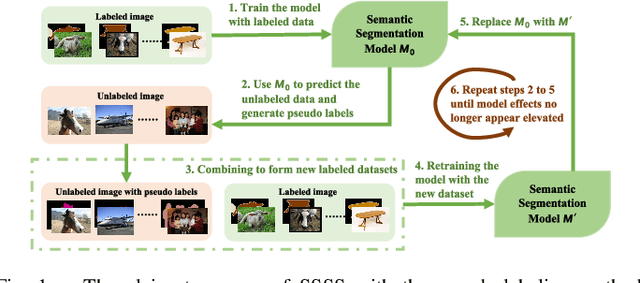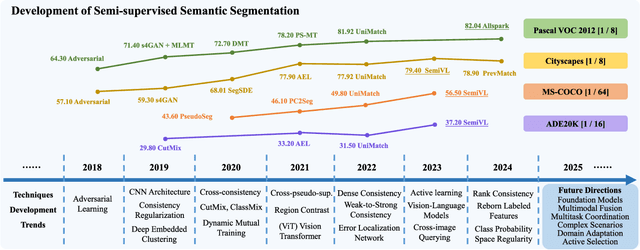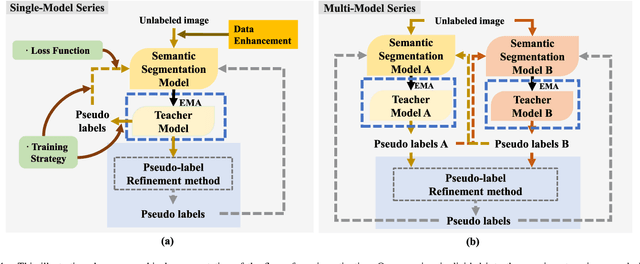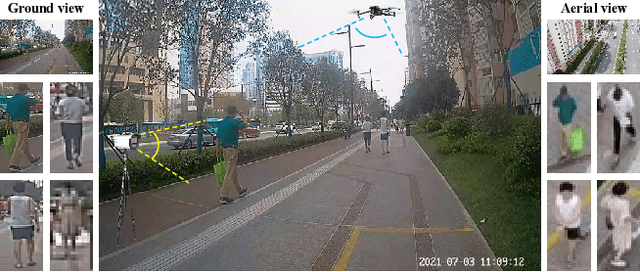Guoqiang Liang
Multi-level Collaborative Distillation Meets Global Workspace Model: A Unified Framework for OCIL
Aug 12, 2025Abstract:Online Class-Incremental Learning (OCIL) enables models to learn continuously from non-i.i.d. data streams and samples of the data streams can be seen only once, making it more suitable for real-world scenarios compared to offline learning. However, OCIL faces two key challenges: maintaining model stability under strict memory constraints and ensuring adaptability to new tasks. Under stricter memory constraints, current replay-based methods are less effective. While ensemble methods improve adaptability (plasticity), they often struggle with stability. To overcome these challenges, we propose a novel approach that enhances ensemble learning through a Global Workspace Model (GWM)-a shared, implicit memory that guides the learning of multiple student models. The GWM is formed by fusing the parameters of all students within each training batch, capturing the historical learning trajectory and serving as a dynamic anchor for knowledge consolidation. This fused model is then redistributed periodically to the students to stabilize learning and promote cross-task consistency. In addition, we introduce a multi-level collaborative distillation mechanism. This approach enforces peer-to-peer consistency among students and preserves historical knowledge by aligning each student with the GWM. As a result, student models remain adaptable to new tasks while maintaining previously learned knowledge, striking a better balance between stability and plasticity. Extensive experiments on three standard OCIL benchmarks show that our method delivers significant performance improvement for several OCIL models across various memory budgets.
AuthFace: Towards Authentic Blind Face Restoration with Face-oriented Generative Diffusion Prior
Oct 13, 2024



Abstract:Blind face restoration (BFR) is a fundamental and challenging problem in computer vision. To faithfully restore high-quality (HQ) photos from poor-quality ones, recent research endeavors predominantly rely on facial image priors from the powerful pretrained text-to-image (T2I) diffusion models. However, such priors often lead to the incorrect generation of non-facial features and insufficient facial details, thus rendering them less practical for real-world applications. In this paper, we propose a novel framework, namely AuthFace that achieves highly authentic face restoration results by exploring a face-oriented generative diffusion prior. To learn such a prior, we first collect a dataset of 1.5K high-quality images, with resolutions exceeding 8K, captured by professional photographers. Based on the dataset, we then introduce a novel face-oriented restoration-tuning pipeline that fine-tunes a pretrained T2I model. Identifying key criteria of quality-first and photography-guided annotation, we involve the retouching and reviewing process under the guidance of photographers for high-quality images that show rich facial features. The photography-guided annotation system fully explores the potential of these high-quality photographic images. In this way, the potent natural image priors from pretrained T2I diffusion models can be subtly harnessed, specifically enhancing their capability in facial detail restoration. Moreover, to minimize artifacts in critical facial areas, such as eyes and mouth, we propose a time-aware latent facial feature loss to learn the authentic face restoration process. Extensive experiments on the synthetic and real-world BFR datasets demonstrate the superiority of our approach.
EvLight++: Low-Light Video Enhancement with an Event Camera: A Large-Scale Real-World Dataset, Novel Method, and More
Aug 29, 2024Abstract:Event cameras offer significant advantages for low-light video enhancement, primarily due to their high dynamic range. Current research, however, is severely limited by the absence of large-scale, real-world, and spatio-temporally aligned event-video datasets. To address this, we introduce a large-scale dataset with over 30,000 pairs of frames and events captured under varying illumination. This dataset was curated using a robotic arm that traces a consistent non-linear trajectory, achieving spatial alignment precision under 0.03mm and temporal alignment with errors under 0.01s for 90% of the dataset. Based on the dataset, we propose \textbf{EvLight++}, a novel event-guided low-light video enhancement approach designed for robust performance in real-world scenarios. Firstly, we design a multi-scale holistic fusion branch to integrate structural and textural information from both images and events. To counteract variations in regional illumination and noise, we introduce Signal-to-Noise Ratio (SNR)-guided regional feature selection, enhancing features from high SNR regions and augmenting those from low SNR regions by extracting structural information from events. To incorporate temporal information and ensure temporal coherence, we further introduce a recurrent module and temporal loss in the whole pipeline. Extensive experiments on our and the synthetic SDSD dataset demonstrate that EvLight++ significantly outperforms both single image- and video-based methods by 1.37 dB and 3.71 dB, respectively. To further explore its potential in downstream tasks like semantic segmentation and monocular depth estimation, we extend our datasets by adding pseudo segmentation and depth labels via meticulous annotation efforts with foundation models. Experiments under diverse low-light scenes show that the enhanced results achieve a 15.97% improvement in mIoU for semantic segmentation.
Towards Robust Event-guided Low-Light Image Enhancement: A Large-Scale Real-World Event-Image Dataset and Novel Approach
Apr 01, 2024Abstract:Event camera has recently received much attention for low-light image enhancement (LIE) thanks to their distinct advantages, such as high dynamic range. However, current research is prohibitively restricted by the lack of large-scale, real-world, and spatial-temporally aligned event-image datasets. To this end, we propose a real-world (indoor and outdoor) dataset comprising over 30K pairs of images and events under both low and normal illumination conditions. To achieve this, we utilize a robotic arm that traces a consistent non-linear trajectory to curate the dataset with spatial alignment precision under 0.03mm. We then introduce a matching alignment strategy, rendering 90% of our dataset with errors less than 0.01s. Based on the dataset, we propose a novel event-guided LIE approach, called EvLight, towards robust performance in real-world low-light scenes. Specifically, we first design the multi-scale holistic fusion branch to extract holistic structural and textural information from both events and images. To ensure robustness against variations in the regional illumination and noise, we then introduce a Signal-to-Noise-Ratio (SNR)-guided regional feature selection to selectively fuse features of images from regions with high SNR and enhance those with low SNR by extracting regional structure information from events. Extensive experiments on our dataset and the synthetic SDSD dataset demonstrate our EvLight significantly surpasses the frame-based methods. Code and datasets are available at https://vlislab22.github.io/eg-lowlight/.
CoLeCLIP: Open-Domain Continual Learning via Joint Task Prompt and Vocabulary Learning
Mar 15, 2024Abstract:This paper explores the problem of continual learning (CL) of vision-language models (VLMs) in open domains, where the models need to perform continual updating and inference on a streaming of datasets from diverse seen and unseen domains with novel classes. Such a capability is crucial for various applications in open environments, e.g., AI assistants, autonomous driving systems, and robotics. Current CL studies mostly focus on closed-set scenarios in a single domain with known classes. Large pre-trained VLMs like CLIP have demonstrated superior zero-shot recognition ability, and a number of recent studies leverage this ability to mitigate catastrophic forgetting in CL, but they focus on closed-set CL in a single domain dataset. Open-domain CL of large VLMs is significantly more challenging due to 1) large class correlations and domain gaps across the datasets and 2) the forgetting of zero-shot knowledge in the pre-trained VLMs in addition to the knowledge learned from the newly adapted datasets. In this work we introduce a novel approach, termed CoLeCLIP, that learns an open-domain CL model based on CLIP. It addresses these challenges by a joint learning of a set of task prompts and a cross-domain class vocabulary. Extensive experiments on 11 domain datasets show that CoLeCLIP outperforms state-of-the-art methods for open-domain CL under both task- and class-incremental learning settings.
Semi-Supervised Semantic Segmentation Based on Pseudo-Labels: A Survey
Mar 04, 2024



Abstract:Semantic segmentation is an important and popular research area in computer vision that focuses on classifying pixels in an image based on their semantics. However, supervised deep learning requires large amounts of data to train models and the process of labeling images pixel by pixel is time-consuming and laborious. This review aims to provide a first comprehensive and organized overview of the state-of-the-art research results on pseudo-label methods in the field of semi-supervised semantic segmentation, which we categorize from different perspectives and present specific methods for specific application areas. In addition, we explore the application of pseudo-label technology in medical and remote-sensing image segmentation. Finally, we also propose some feasible future research directions to address the existing challenges.
DMAT: A Dynamic Mask-Aware Transformer for Human De-occlusion
Feb 07, 2024Abstract:Human de-occlusion, which aims to infer the appearance of invisible human parts from an occluded image, has great value in many human-related tasks, such as person re-id, and intention inference. To address this task, this paper proposes a dynamic mask-aware transformer (DMAT), which dynamically augments information from human regions and weakens that from occlusion. First, to enhance token representation, we design an expanded convolution head with enlarged kernels, which captures more local valid context and mitigates the influence of surrounding occlusion. To concentrate on the visible human parts, we propose a novel dynamic multi-head human-mask guided attention mechanism through integrating multiple masks, which can prevent the de-occluded regions from assimilating to the background. Besides, a region upsampling strategy is utilized to alleviate the impact of occlusion on interpolated images. During model learning, an amodal loss is developed to further emphasize the recovery effect of human regions, which also refines the model's convergence. Extensive experiments on the AHP dataset demonstrate its superior performance compared to recent state-of-the-art methods.
Ground-to-Aerial Person Search: Benchmark Dataset and Approach
Aug 24, 2023



Abstract:In this work, we construct a large-scale dataset for Ground-to-Aerial Person Search, named G2APS, which contains 31,770 images of 260,559 annotated bounding boxes for 2,644 identities appearing in both of the UAVs and ground surveillance cameras. To our knowledge, this is the first dataset for cross-platform intelligent surveillance applications, where the UAVs could work as a powerful complement for the ground surveillance cameras. To more realistically simulate the actual cross-platform Ground-to-Aerial surveillance scenarios, the surveillance cameras are fixed about 2 meters above the ground, while the UAVs capture videos of persons at different location, with a variety of view-angles, flight attitudes and flight modes. Therefore, the dataset has the following unique characteristics: 1) drastic view-angle changes between query and gallery person images from cross-platform cameras; 2) diverse resolutions, poses and views of the person images under 9 rich real-world scenarios. On basis of the G2APS benchmark dataset, we demonstrate detailed analysis about current two-step and end-to-end person search methods, and further propose a simple yet effective knowledge distillation scheme on the head of the ReID network, which achieves state-of-the-art performances on both of the G2APS and the previous two public person search datasets, i.e., PRW and CUHK-SYSU. The dataset and source code available on \url{https://github.com/yqc123456/HKD_for_person_search}.
Self-supervised Learning of Event-guided Video Frame Interpolation for Rolling Shutter Frames
Jun 27, 2023Abstract:This paper makes the first attempt to tackle the challenging task of recovering arbitrary frame rate latent global shutter (GS) frames from two consecutive rolling shutter (RS) frames, guided by the novel event camera data. Although events possess high temporal resolution, beneficial for video frame interpolation (VFI), a hurdle in tackling this task is the lack of paired GS frames. Another challenge is that RS frames are susceptible to distortion when capturing moving objects. To this end, we propose a novel self-supervised framework that leverages events to guide RS frame correction and VFI in a unified framework. Our key idea is to estimate the displacement field (DF) non-linear dense 3D spatiotemporal information of all pixels during the exposure time, allowing for the reciprocal reconstruction between RS and GS frames as well as arbitrary frame rate VFI. Specifically, the displacement field estimation (DFE) module is proposed to estimate the spatiotemporal motion from events to correct the RS distortion and interpolate the GS frames in one step. We then combine the input RS frames and DF to learn a mapping for RS-to-GS frame interpolation. However, as the mapping is highly under-constrained, we couple it with an inverse mapping (i.e., GS-to-RS) and RS frame warping (i.e., RS-to-RS) for self-supervision. As there is a lack of labeled datasets for evaluation, we generate two synthetic datasets and collect a real-world dataset to train and test our method. Experimental results show that our method yields comparable or better performance with prior supervised methods.
Learning Conditional Attributes for Compositional Zero-Shot Learning
Jun 14, 2023



Abstract:Compositional Zero-Shot Learning (CZSL) aims to train models to recognize novel compositional concepts based on learned concepts such as attribute-object combinations. One of the challenges is to model attributes interacted with different objects, e.g., the attribute ``wet" in ``wet apple" and ``wet cat" is different. As a solution, we provide analysis and argue that attributes are conditioned on the recognized object and input image and explore learning conditional attribute embeddings by a proposed attribute learning framework containing an attribute hyper learner and an attribute base learner. By encoding conditional attributes, our model enables to generate flexible attribute embeddings for generalization from seen to unseen compositions. Experiments on CZSL benchmarks, including the more challenging C-GQA dataset, demonstrate better performances compared with other state-of-the-art approaches and validate the importance of learning conditional attributes. Code is available at https://github.com/wqshmzh/CANet-CZSL
 Add to Chrome
Add to Chrome Add to Firefox
Add to Firefox Add to Edge
Add to Edge